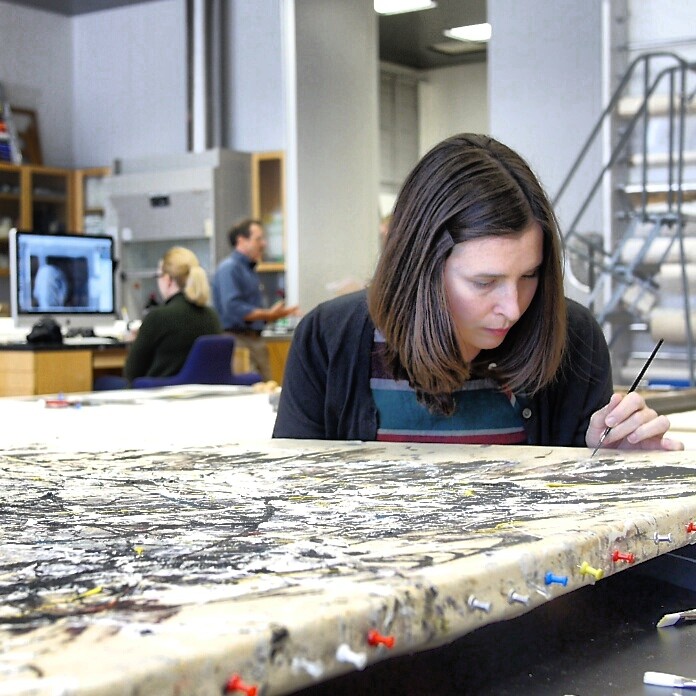Update: Pollock Restorations at MoMA Draw to a Close & Corporate America Steps In
Ruth Osborne

Conservators at MoMA laying down Pollock’s One: Number 31, 1950.
Last December, ArtWatch posted on three major works by Jackson Pollock then undergoing restoration at MoMA and the Seattle Museum of Art.
This was not to be the first time these canvases had been under a restorer’s hand; Sea Change (1947) was varnished in 1970,[1] One (1950) underwent overpainting in the 1960s[2], and Echo (1951) has experienced yellowing over the decades.[3] The museums’ conservators set out to remove the poorly-executed treatments of decades past and bring the canvases back to their original state in Pollock’s studio.
While One and Echo have completed their treatments and are now on view, work at MoMA has recently begun on Number 1A, 1948. This work of Pollock’s comes with a “condition and treatment history” that is “arguably the most complex” of all three.[4] According to Museum records, the last major conservation in 1959 attempted to restore the canvas from “heat and smoke exposure” as a result of a fire in the galleries the year before. MoMA admits this treatment in ‘59 has now resulted in the painting’s discolored and disfigured appearance today.[5] However, current treatment on Number 1A, 1948 would not have been able to continue without generous funding from the Bank of America’s Global Art Conservation Project.
Coddington states in a video on the project posted on the Forbes website, that MoMA would likely not have undergone treatment for Number1A if Bank of America had not stepped in with funding. The endeavor originally began as an in-house conservation project (see Einav Zamir’s November 2012 post). And yet, the Bank’s Conservation Project website proudly lists all three Pollocks at MoMA among those fortunate enough to have received funding this year. All three.

Jennifer Hick, MoMA Conservator, at work on Number 1A, 1948. Courtesy: Forbes / Will Sanderson.
A recent Forbes article, aptly titled “How Bank of America Uses Fine Art to Make You Like Them,” takes an curious and criticizing eye to Bank of America’s involvement in the process: “Surveys have found that customers who say they care about the arts rate the bank higher in terms of satisfaction.”[6] As ArtWatch pointed out in a post last month, ulterior motives often behind restoration treatments are simple painted over with a thin layer of support for the arts. These corporate funding projects are not in existence for the benefit of the works of art themselves. As Zamir points out, it is not unthinkable that pieces are selected for their high profile status in order to gain more press coverage. What need was there to suddenly begin restorations on Pollock’s oeuvre? To use the artist’s name as a branding tool to sell the charitable façade of public corporations.
[1] “Pollack Restoration at Seattle Museum of Art is Coming Along,” Nov. 28, 2012. AFA News. http://www.afanews.com/home/item/1424-pollack-restoration-at-seattle-museum-of-art-is-coming-along#.UlzNOiioflM (last visited 15 October 2013).
[2] James Coddington and Jennifer Hickey, “MoMA’s Jackson Pollock Conservation Project: Wrapping Up Treatment of One: Number 31, 1950.” May 29, 2013. MoMA INSIDE/OUT. http://www.moma.org/explore/inside_out/2013/05/29/momas-jackson-pollock-conservation-project-wrapping-up-treatment-of-one-number-31-1950/ (last visited 15 October 2013).
[3] Hickey, “MoMA’s Jackson Pollock Conservation Project, Post 3: Documentation and Treatment.” 2 October 2011. MoMA INSIDE/OUT. http://www.moma.org/explore/inside_out/2012/10/02/momas-jackson-pollock-conservation-project-post-3-documentation-and-treatment (last visited 15 October 2013).
[4] Ibid.
[5] Hickey and Coddington, “MoMA’s Jackson Pollock Conservation Project: Number 1A, 1948,” 18 July 2013. MoMA INSIDE/OUT. http://www.moma.org/explore/inside_out/2013/07/18/momas-jackson-pollock-conservation-project-number-1a-1948 (last visited 15 October 2013).
[6] Samantha Sharf, “Jackson Pollock Brand Ambassador? How Bank of America Uses Fine Art to Make You Like Them,” 8 October 2013. Forbes. http://www.forbes.com/sites/samanthasharf/2013/10/08/jackson-pollock-brand-ambassador-how-bank-of-america-uses-fine-art-to-make-you-like-them/ (last visited 15 October 2013).









Leave a Reply
Want to join the discussion?Feel free to contribute!